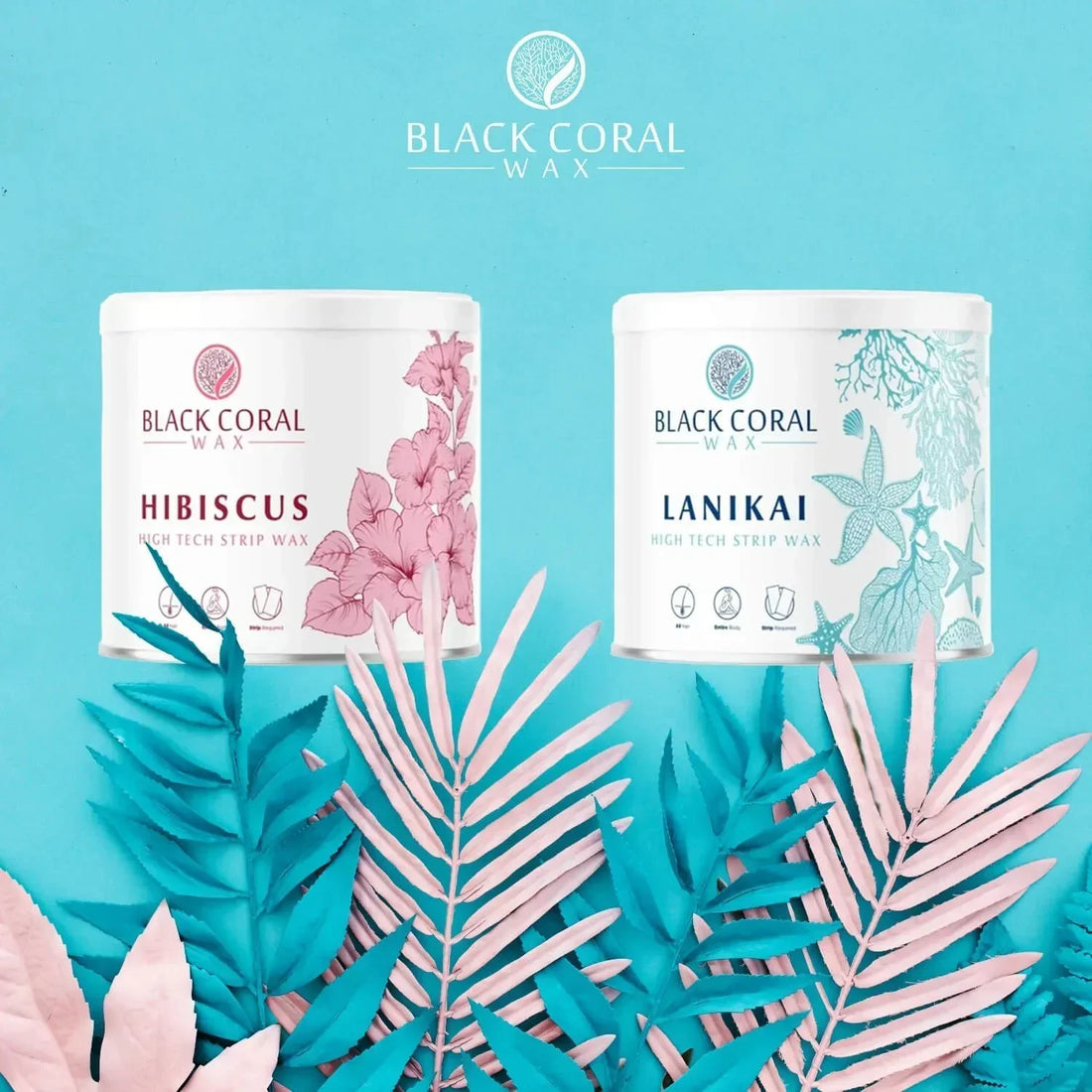Ready to step up your waxing game but unsure whether to go with soft or hard wax? This ultimate guide is for you! Here, we'll explore the differences, delve into the application techniques, and tackle the pain factor. Weigh the pros and cons to decide what suits your unique needs. Remember, there's no one-size-fits-all in waxing, so let's find your perfect match. Welcome to the world of soft wax vs. hard wax.
Understanding Wax Types
Now, let's dive into understanding the two main types of wax you'll encounter: soft wax and hard wax, each with its own unique benefits and drawbacks.
The differences begin at the most basic level: their ingredients. Soft wax often contains resins, which makes it more adhesive and effective in removing hair from larger areas like your arms and legs. On the other hand, hard wax may include polymers, allowing it to be pliable and less irritating to the skin, perfect for sensitive areas like your underarms, face, and bikini line.
Exploring hair removal efficiency, soft wax wins on larger areas because of its stickiness. It's capable of gripping and removing even the finest hairs. Hard wax, however, is less efficient on larger areas but is excellent for smaller, sensitive zones due to its ability to shrink wrap around the hair and not stick to the skin.
When examining cost effectiveness, soft wax tends to be more economical as a little goes a long way, whereas hard wax requires a thicker application. Yet, hard wax could save you money in the long run if you're waxing smaller areas or have sensitive skin, due to its reduced potential for skin irritation.
Analyzing long term effects, both waxes contribute to less hair regrowth over time, but hard wax might lead to fewer ingrown hairs.
Considering environmental impact, both types of wax are typically available in recyclable packaging. However, soft wax uses disposable strips for removal, adding to waste, while hard wax does not.
As you can see, the choice between soft and hard wax depends largely on your specific needs, skin sensitivity, and the area you wish to wax.
Comparing Application Techniques
When it comes to comparing the application techniques, there's quite a difference between the two. Soft wax is spread thinly over your skin, and a cloth or paper strip is pressed on top. The strip is then swiftly pulled off in the opposite direction of hair growth, removing both the wax and the hair. On the other hand, hard wax is applied in a thick layer and allowed to cool and harden. Once hardened, it's swiftly removed, pulling the hair out from the root.
The differences in effectiveness between the two are notable. Soft wax can efficiently remove hair from larger areas, such as your arms and legs. However, hard wax is often more effective for smaller, sensitive areas like your face, underarms, and bikini line.
As for comparing cost, soft wax is generally cheaper and can cover larger areas faster. However, hard wax can be more cost-effective in the long run as it's often less irritating to the skin, potentially saving you on soothing lotions and creams.
Exploring longevity, both waxes can provide smooth skin for about four to six weeks, depending on your hair growth rate. However, hard wax may give longer-lasting results on sensitive areas.
Considering skin sensitivity, hard wax is often the better choice. It only sticks to the hair, not the skin, minimizing potential discomfort.
Examining potential side effects, soft wax may cause more skin redness and irritation due to its adhesive nature, while hard wax is often gentler. But remember, everyone's skin reacts differently. It's important to test a small patch of skin first to see how it reacts.
So, when deciding between soft and hard wax, consider these factors. Your choice should align with your needs, preferences, and skin type.
Assessing Pain Sensitivity
In terms of pain sensitivity, it's generally accepted that hard wax is less painful than soft wax. This is because hard wax adheres only to the hair and not the skin, making the removal process less intense. Still, everyone's pain perception differs, and what might be a breeze for one person could be a challenge for another.
One way to handle waxing discomfort is through pain management techniques. Breathing exercises, for instance, can help you relax during the procedure. It's about staying calm and centered, even when the wax strip is being pulled off. The more relaxed you are, the less painful the experience will be.
Numbing creams, available over the counter, can also be your ally. Apply these creams about 30 minutes before the waxing process to minimize discomfort. Remember, these are not necessarily a solution but can certainly help in making the experience more bearable.
Your waxing frequency can also affect your pain sensitivity. Regular waxing can, over time, cause the hair to grow back finer and sparser, making each subsequent waxing session less painful.
Lastly, if you've got sensitive skin, hard wax might be your go-to option. It's gentler on the skin, reducing the chances of irritation or inflammation post-wax.
So, when you're deciding between soft and hard wax, consider not just the area you're waxing, but also your pain tolerance and skin sensitivity. Remember, waxing doesn't have to be a dreaded experience. With the right approach, you can make it a bearable, if not entirely pain-free, part of your beauty routine.
Weighing Pros and Cons
Let's delve into the advantages and disadvantages of each wax type to help you make an informed decision.
Soft wax is known for its effectiveness on larger areas like your arms and legs. It's a time-efficient method that leaves you with long-lasting results. However, the flip side is that soft wax may cause skin reactions in some people due to its adhesive nature. It's excellent for fine hair but can sometimes be too harsh for coarse hair.
On the other hand, hard wax is ideal for sensitive areas like your face, underarms, and bikini line. It's less likely to cause skin reactions as it only adheres to the hair and not the skin, which is a significant advantage. However, in an effectiveness comparison, it might not be as efficient as soft wax in removing fine hair.
When we talk about cost analysis, soft wax can be more economical as less product is used per application. Hard wax, on the other hand, requires a thicker layer, meaning you might run through the product quicker.
Time efficiency is another factor to consider. While soft wax can quickly cover large areas, hard wax requires more careful application, so it might take longer. However, it tends to be less painful, which is a big plus if you have a low pain threshold.
Your choice between soft and hard wax ultimately depends on your personal preferences, skin type, and the area you want to wax. Both have their strengths and weaknesses, but understanding these can help you choose the one that best suits your needs and comfort level.
Choosing the Right Wax
Choosing the right wax isn't just about weighing pros and cons; it's also about understanding your skin type, the specific body area you want to wax, and your personal comfort level.
Considering your skin type is a crucial first step. If you have sensitive skin that's prone to redness and irritation, hard wax might be your best bet due to its gentle nature. On the other hand, if your skin is resilient and you're looking to wax larger areas, soft wax could be the more efficient option.
Evaluating the body area you intend to wax is the next step. Hard wax is typically favored for delicate areas like the face, underarms, and bikini line because it adheres to the hair, not the skin. This means less pull on the skin, reducing discomfort. Conversely, soft wax can cover larger areas like the legs and arms more quickly and effectively.
Factoring in personal preferences is essential too. If you value convenience and speed, you might lean towards soft wax. However, if comfort is a priority and you're exploring your pain tolerance, hard wax is often seen as the less painful alternative.
Analyzing your experience level is also important. Soft wax can be a little trickier to work with for beginners due to the need for cloth or paper strips for removal. Hard wax, on the other hand, hardens and is removed as a whole piece, which some find simpler and more intuitive.
Remember, there's no one-size-fits-all answer. It's about choosing what works best for your individual needs and circumstances. So, experiment and discover what's most comfortable and effective for you.
Discover Our Soft Wax Collection
Lanikai Soft Wax: Lanikai is one of our newest additions, specially formulated for efficient hair removal on larger areas of the body. Its unique blend ensures a smooth and effective waxing process, leaving your skin silky and hair-free.
Hibiscus Soft Wax: Another exciting addition to our range is Hibiscus Soft Wax. This wax is perfect for those seeking a gentle yet efficient hair removal solution for sensitive areas. Say goodbye to irritation and discomfort with Hibiscus.
Maui Lavender Soft Wax: In addition to Lanikai and Hibiscus, we also offer Maui Lavender Soft Wax. This wax is the original Black Coral Wax’s soft wax suitable for various body areas. Its soothing lavender infusion adds an extra layer of relaxation to your waxing experience.
These new products from Black Coral Wax provide you with even more choices when it comes to selecting the right wax for your needs.
Check them out now!
Conclusion
In the end, it's all about what works best for you. Whether you prefer soft wax's efficiency for large areas or hard wax's gentleness for sensitive zones, the choice is yours.
Remember, proper care before and after waxing is crucial. Use this guide to make an informed decision that suits your skin type, pain tolerance, and convenience preferences.
Happy waxing!






